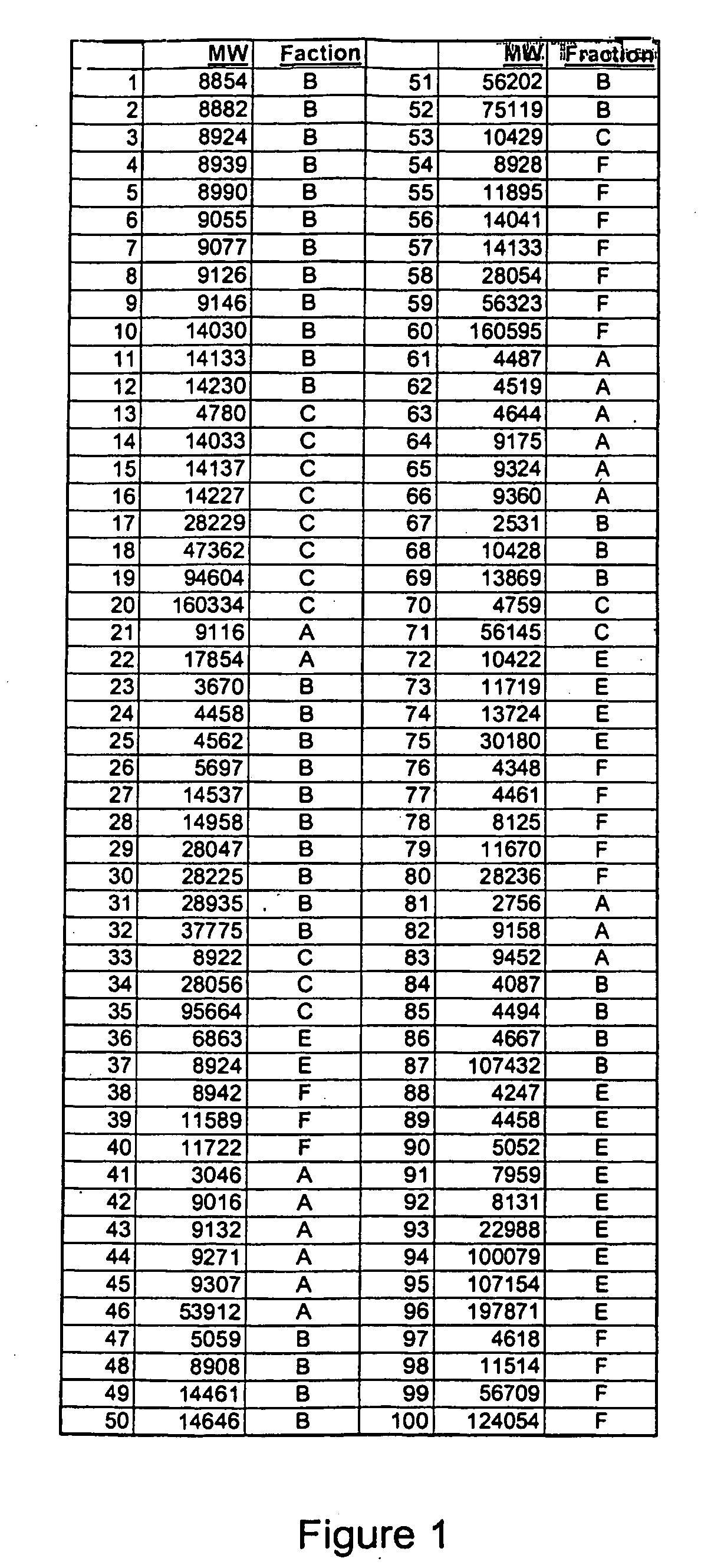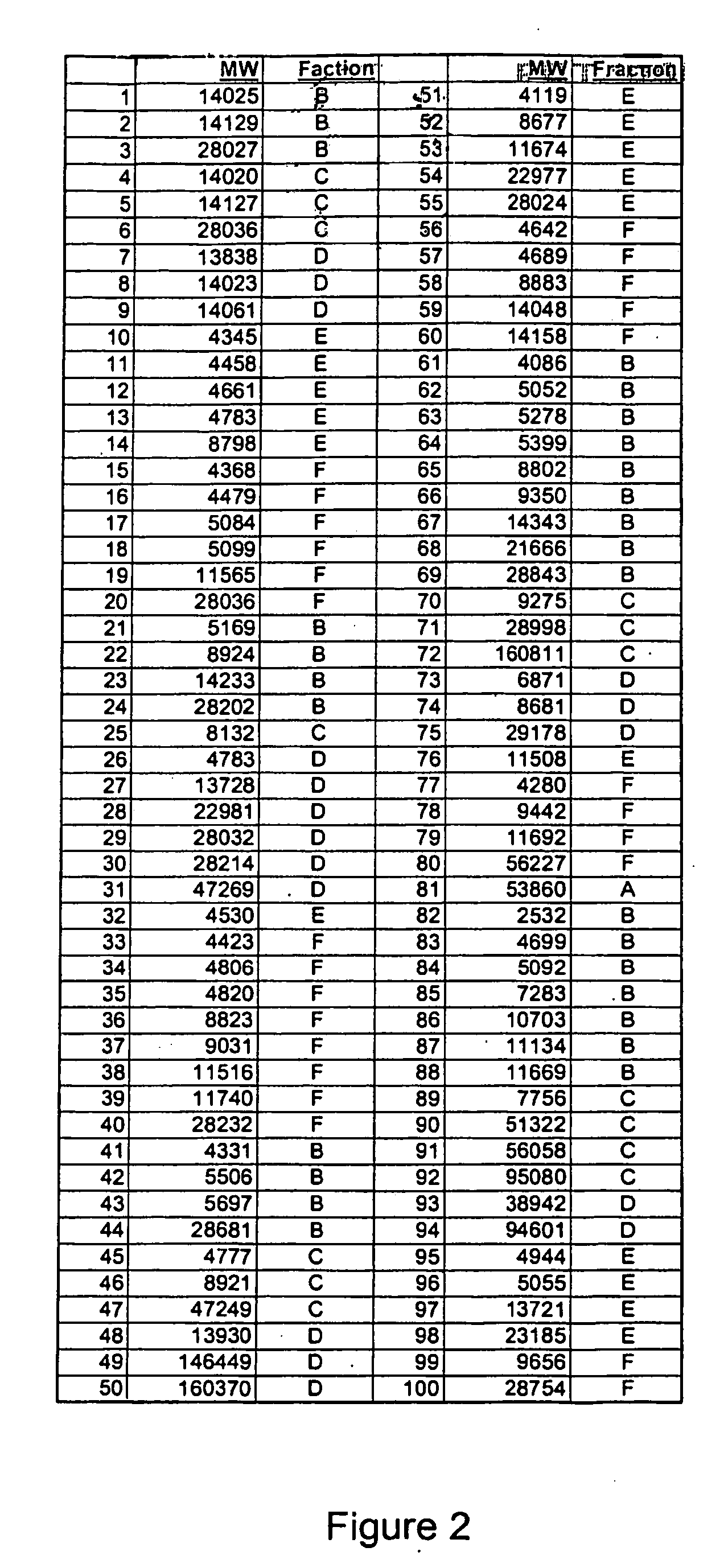Serum biomarkers in hepatocellular carcinoma
a hepatocellular carcinoma and serum biomarker technology, applied in the field of serum biomarkers in hepatocellular carcinoma, can solve the problems of poor prognosis, time-consuming, laborious, and none of these have a predictive value even as high as afp
- Summary
- Abstract
- Description
- Claims
- Application Information
AI Technical Summary
Benefits of technology
Problems solved by technology
Method used
Image
Examples
example i
[0100] With the patients' consent, clotted blood samples were collected from 40 patients with HCC and 21 patients with chronic liver diseases at presentation, and stored at −70° C. before assay. Patients with HCC were diagnosed according to standard clinical criteria. All HCC cases were histologically confirmed. Among the HCC cases, 18 had serum AFP levels >500 ng / ml, and 22 had a serum AFP level 500 ng / mL (905 ng / mL) was also analyzed in this study. Aside from analysing each serum sample individually, serum samples from HCC patients with AFP >500 ng / ml, and those from HCC patients with AFP <500 ng / ml were pooled as samples HCCP1 and HCCP2 respectively, while serum samples from the control group were pooled as sample CLDP1. The serum AFP levels were measured by microparticle EIA (MEIA, Abbott Laboratories, Chicago, USA).
example 2
Fractionation of serum
[0101] Buffers:
[0102] 1. U9 (9M urea, 2% CHAPS, 50 mM Tris-HCl pH9)
[0103] 2. U1 (1M urea, 0.22% CHAPS, 50 mM Tris-HCl pH9)
[0104] 3. wash buffer 1: 50 mM Tris-HCl with 0.1% n-octyl β-D-Glucopyranoside (OGP) pH9
[0105] 4. wash buffer 2: 100 mM sodium phosphate with 0.1% OGP pH7
[0106] 5. wash buffer 3: 100 mM sodium acetate with 0.1% OGP pH5
[0107] 6. wash buffer 4: 100 mM sodium acetate with 0.1% OGP pH4
[0108] 7. wash buffer 5: 50 mM sodium citrate with 0.1% OGP pH3
[0109] 8. wash buffer 6: 33.3% isopropanol / 16.7% acetonitrile / 0.1% trifluoroacetic acid in water
[0110] Anion exchange fractionation can be regarded as analogous to the first dimensional separation, isoelectric focusing, in the 2D PAGE technology. Both technologies separate proteins on the basis of their pI values. Thirty microliters of U9 buffer were added to 20 μL of serum in a tube and were mixed at 4° C. for 20 minutes. Ion exchange resin (Q Ceramic HyperDF ion exchange resin, Biosepra SA, F...
example 3
SELDI Analysis of Fractionated Serum
[0111] ProteinChip® Arrays were set up in 96-well bioprocessors. Buffer delivery and sample incubation were performed on a Biomek 2000 Automation Workstation. Each serum fraction was analyzed on IMAC3 (loaded with copper) and WCX2 ProteinChip® Arrays in duplicates. The different ProteinChip surfaces (2nd dimension) helped to identify very low abundance proteins. The IMAC3 copper and WCX2 ProteinChip surfaces preferentially retain different groups of proteins according to their physiochemical properties.
[0112] The IMAC3 copper and WCX2 arrays (Ciphergen Biosystems Inc, Fremont, Calif.) were equilibrated two times with 150 μL of binding buffer (100 mM sodium phosphate+0.5M NaCl pH7 for IMAC3, 100 mM sodium acetate pH4 for WCX2). Each serum fraction was diluted in the corresponding binding buffer (⅕ dilution for IMAC3 and 1 / 10 dilution for WCX2) and 100 μL was applied to each ProteinChip® array. Incubation was performed on a platform shaker at room...
PUM
 Login to View More
Login to View More Abstract
Description
Claims
Application Information
 Login to View More
Login to View More - R&D
- Intellectual Property
- Life Sciences
- Materials
- Tech Scout
- Unparalleled Data Quality
- Higher Quality Content
- 60% Fewer Hallucinations
Browse by: Latest US Patents, China's latest patents, Technical Efficacy Thesaurus, Application Domain, Technology Topic, Popular Technical Reports.
© 2025 PatSnap. All rights reserved.Legal|Privacy policy|Modern Slavery Act Transparency Statement|Sitemap|About US| Contact US: help@patsnap.com


